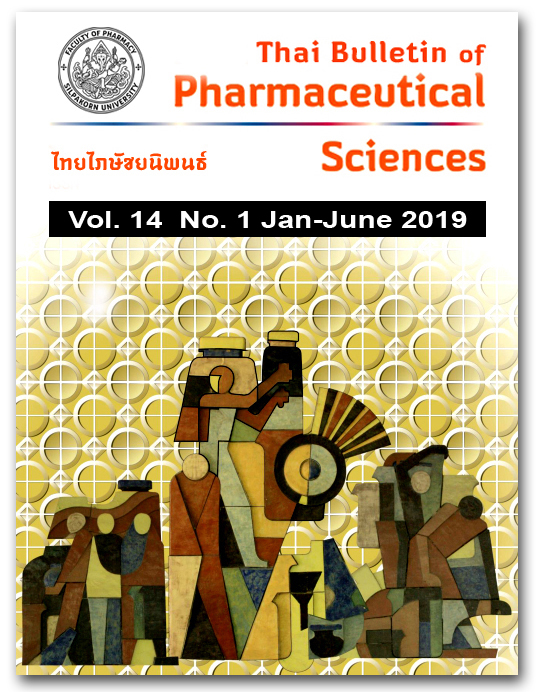COMPARISON OF PICEATANNOL CONTENT IN SEED COAT AND EMBRYO OF PASSION FRUIT
DOI:
https://doi.org/10.69598/tbps.14.1.35-48Keywords:
passion fruit, seeds, seed coat, embryo, piceatannol, extractionAbstract
The aim of the present study was to investigate the use of seed coat of passion fruit seeds prepared by rinsing milled seeds in water for the extraction of piceatannol. The dry matter content of the embryo and the seed coat in the total seeds was 40% (w/w) and 60% (w/w), respectively. The content of piceatannol in the dried total seeds was 0.51% (w/w). It was found that piceatannol was contained substantially only in the seed coat at approximately 0.8% (w/w) of the dried seed coat, while piceatannol was not found in the embryo. The content and the recovery of piceatannol in the extracts prepared by the repeated batch extraction (round 1, 2, and 3) under the various extraction conditions from the total seeds, the seed coat, and the embryo were compared. The content of piceatannol in the extract of round 1, prepared by the extraction condition of refluxing the seed coat in 60% (v/v) ethanol, was 9.5% (w/w) at the maximal recovery of piceatannol (81.9%). By using the synthetic adsorbent and ethyl acetate/0.5% (w/v) sodium bicarbonate partition, the extract containing piceatannol (approximately 20-25%, w/w) was obtained. The present study demonstrated that the use of seed coat was efficient for preparing the extract containing higher amount of piceatannol.
References
2. Sano S, Sugiyama K, Ito T, Katano Y, Ishihata A. Identification of the strong vasorelaxing substance scirpusin B, a dimer of piceatannol, from passion fruit (Passiflora edulis) seeds. J Agric Food Chem. 2011;59:6209-13.
3. de Oliveira RC, de Barros STD, Gimenes ML. The extraction of passion fruit oil with green solvents.J Food Eng. 2013;117:458-63.
4. Liu S, Yang F, Li J, Zhang C, Ji H, Hong P. Physical and chemical analysis of Passiflora seeds and oil from China. Int J Food Sci Nutr. 2008;59:706-15.
5. Piotrowska H, Kucinska M, Murias M. Biological activity of piceatannol: leaving the shadow of resveratrol. Mutat Res. 2012;750:60-82.
6. Song NR, Hwang MK, Heo YS, Lee KW, Lee HJ. Piceatannol suppresses the metastatic potential of MCF10A human breast epithelial cells harboring mutated H-ras by inhibiting MMP-2 expression. Int J Mol Med. 2013;32(4):775-84.
7. Matsui Y, Sugiyama K, Kamei M, Takahashi T, Suzuki T, Y. Katagata Y, et al. Extract of passion fruit (Passiflora edulis) seed containing high amounts of piceatannol inhibits melanogenesis and promotes collagen synthesis. J Agric Food Chem. 2010;58:11112-8.
8. Maruki-Uchida H, Kurita I, Sugiyama K, Sai M, Maeda K, Ito T. The protective effects of piceatannol from passion fruit (Passiflora edulis) seeds in UVB-irradiated keratinocytes. Biol Pharm Bull. 2013;36:845-9.
9. Kinoshita Y, Kawakami S, Yanae K, Sano S, Uchida H, Inagaki H, et al. Effect of long-term piceatannol treatment on eNOS levels in cultured endothelial cells. Biochem Biophys Res Commun. 2013;430:1164-8.
10. Kee HJ, Park S, Kang W, Lim KS, Kim JH, Ahn Y, et al. Piceatannol attenuates cardiac hypertrophy in an animal model through regulation of the expression and binding of the transcription factor GATA binding factor 6. FEBS Lett. 2014;588:1529-36.
11. Les F, Deleruyelle S, Cassagnes LE, Boutin JA, Balogh B, Arbones-Mainar JM, et al. Piceatannol and resveratrol share inhibitory effects on hydrogen peroxide release, monoamine oxidase and lipogenic activities in adipose tissue, but differ in their antilipolytic properties. Chem-Biol Interact. 2016;258:115-25.
12. Zhang AJ, Rimando AM, Mizuno CS, Mathews ST. α-Glucosidase inhibitory effect of resveratrol and piceatannol. J Nutr Biochem. 2017;47:86-93.
13. Yamamoto T, Li Y, Hanafusa Y, Yeh YS, Maruki-Uchida H, Kawakami S, et al. Piceatannol exhibits anti-inflammatory effects on macrophages interacting with adipocytes. Food Sci Nutr. 2017;5:76-85.
14. Mizusaki A, Nishi K, Nishiwaki H, Ishida M, Tamamoto T, Sugahara T. Suppressive effect of ethanol extract from passion fruit seeds on IgE production. J Funct Foods. 2017;32:176-84.
15. Viganó J, Aguiar AC, Moraes DR, Jara JLP, Eberlin MN, Cazarin CBB, et al. Sequential high pressure extractions applied to recover piceatannol and scirpusin B from passion fruit bagasse. Food Res Int. 2016;85:51-8.
16. Padmore JM, editor. Animal feed. In: Association of Official and Analytical Chemists; Horwitz W, Latimer GW, editors. AOAC official methods of analysis. 18th ed. Gaitherburg (MD): AOAC International; 2005. p.69-88.
17. Han SY, Bang HB, Lee HS, Hwang JW, Choi DH, Yang DM, et al. A new synthesis of stilbene natural product piceatannol. Bull Korean Chem Soc. 2008;29:1800-2.
18. Mathi P, Das S, Nikhil K, Roy P, Yerra S, Ravada SR, et al. Isolation and characterization of the anticancer compound piceatannol from Sophora interrupta Bedd. Int J Prev Med. 2015;6:101.
Downloads
Published
How to Cite
Issue
Section
License
All articles published and information contained in this journal such as text, graphics, logos and images is copyrighted by and proprietary to the Thai Bulletin of Pharmaceutical Sciences, and may not be reproduced in whole or in part by persons, organizations, or corporations other than the Thai Bulletin of Pharmaceutical Sciences and the authors without prior written permission.


